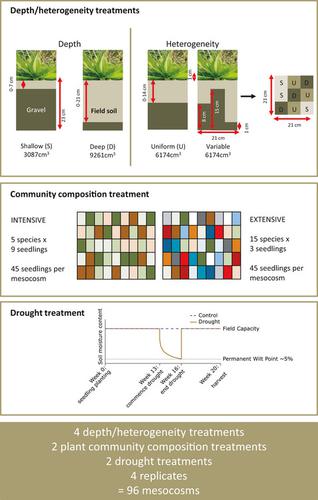当前位置:
X-MOL 学术
›
Ecol. Evol.
›
论文详情
Our official English website, www.x-mol.net, welcomes your feedback! (Note: you will need to create a separate account there.)
Do soil depth and plant community composition interact to modify the resistance and resilience of grassland ecosystem functioning to drought?
Ecology and Evolution ( IF 2.6 ) Pub Date : 2021-07-27 , DOI: 10.1002/ece3.7963 Ellen L Fry 1, 2 , Anna Wilkinson 1 , David Johnson 1 , William James Pritchard 1 , Nick J Ostle 3, 4 , Elizabeth M Baggs 5 , Richard D Bardgett 1
Ecology and Evolution ( IF 2.6 ) Pub Date : 2021-07-27 , DOI: 10.1002/ece3.7963 Ellen L Fry 1, 2 , Anna Wilkinson 1 , David Johnson 1 , William James Pritchard 1 , Nick J Ostle 3, 4 , Elizabeth M Baggs 5 , Richard D Bardgett 1
Affiliation

|
While the effect of drought on plant communities and their associated ecosystem functions is well studied, little research has considered how responses are modified by soil depth and depth heterogeneity. We conducted a mesocosm study comprising shallow and deep soils, and variable and uniform soil depths, and two levels of plant community composition, and exposed them to a simulated drought to test for interactive effects of these treatments on the resilience of carbon dioxide fluxes, plant functional traits, and soil chemical properties. We tested the hypotheses that: (a) shallow and variable depth soils lead to increased resistance and resilience of ecosystem functions to drought due to more exploitative plant trait strategies; (b) plant communities associated with intensively managed high fertility soils, will have more exploitative root traits than extensively managed, lower fertility plant communities. These traits will be associated with higher resistance and resilience to drought and may interact with soil depth and depth heterogeneity to amplify the effects on ecosystem functions. Our results showed that while there were strong soil depth/heterogeneity effects on plant-driven carbon fluxes, it did not affect resistance or resilience to drought, and there were no treatment effects on plant-available carbon or nitrogen. We did observe a significant increase in exploitative root traits in shallow and variable soils relative to deep and uniform, which may have resulted in a compensation effect which led to the similar drought responses. Plant community compositions representative of intensive management were more drought resilient than more diverse “extensive” communities irrespective of soil depth or soil depth heterogeneity. In intensively managed plant communities, root traits were more representative of exploitative strategies. Taken together, our results suggest that reorganization of root traits in response to soil depth could buffer drought effects on ecosystem functions.
中文翻译:

土壤深度和植物群落组成是否相互作用以改变草地生态系统对干旱的抵抗力和恢复力?
虽然干旱对植物群落及其相关生态系统功能的影响得到了很好的研究,但很少有研究考虑土壤深度和深度异质性如何改变响应。我们进行了一项包括浅层和深层土壤、可变且均匀的土壤深度以及两个水平的植物群落组成的中宇宙研究,并将它们暴露于模拟干旱中,以测试这些处理对二氧化碳通量、植物恢复能力的交互作用功能性状和土壤化学性质。我们测试了以下假设:(a) 由于更具开发性的植物性状策略,浅层和不同深度的土壤导致生态系统功能对干旱的抵抗力和恢复力增加;(b) 与集约化管理的高肥力土壤相关的植物群落,将比广泛管理的低肥力植物群落具有更多的剥削性根特征。这些性状将与更高的抗旱性和恢复力相关,并可能与土壤深度和深度异质性相互作用,以放大对生态系统功能的影响。我们的结果表明,虽然土壤深度/异质性对植物驱动的碳通量有很强的影响,但它不影响对干旱的抵抗力或恢复力,对植物可用碳或氮没有处理影响。我们确实观察到相对于深层和均匀土壤,浅层和可变土壤中的可开发性根系特征显着增加,这可能导致补偿效应,导致类似的干旱响应。无论土壤深度或土壤深度异质性如何,代表集约化管理的植物群落组成比更多样化的“广泛”群落更具抗旱性。在集约化管理的植物群落中,根系特征更能代表剥削策略。总之,我们的结果表明,响应土壤深度的根性状重组可以缓冲干旱对生态系统功能的影响。
更新日期:2021-09-09
中文翻译:

土壤深度和植物群落组成是否相互作用以改变草地生态系统对干旱的抵抗力和恢复力?
虽然干旱对植物群落及其相关生态系统功能的影响得到了很好的研究,但很少有研究考虑土壤深度和深度异质性如何改变响应。我们进行了一项包括浅层和深层土壤、可变且均匀的土壤深度以及两个水平的植物群落组成的中宇宙研究,并将它们暴露于模拟干旱中,以测试这些处理对二氧化碳通量、植物恢复能力的交互作用功能性状和土壤化学性质。我们测试了以下假设:(a) 由于更具开发性的植物性状策略,浅层和不同深度的土壤导致生态系统功能对干旱的抵抗力和恢复力增加;(b) 与集约化管理的高肥力土壤相关的植物群落,将比广泛管理的低肥力植物群落具有更多的剥削性根特征。这些性状将与更高的抗旱性和恢复力相关,并可能与土壤深度和深度异质性相互作用,以放大对生态系统功能的影响。我们的结果表明,虽然土壤深度/异质性对植物驱动的碳通量有很强的影响,但它不影响对干旱的抵抗力或恢复力,对植物可用碳或氮没有处理影响。我们确实观察到相对于深层和均匀土壤,浅层和可变土壤中的可开发性根系特征显着增加,这可能导致补偿效应,导致类似的干旱响应。无论土壤深度或土壤深度异质性如何,代表集约化管理的植物群落组成比更多样化的“广泛”群落更具抗旱性。在集约化管理的植物群落中,根系特征更能代表剥削策略。总之,我们的结果表明,响应土壤深度的根性状重组可以缓冲干旱对生态系统功能的影响。


























 京公网安备 11010802027423号
京公网安备 11010802027423号